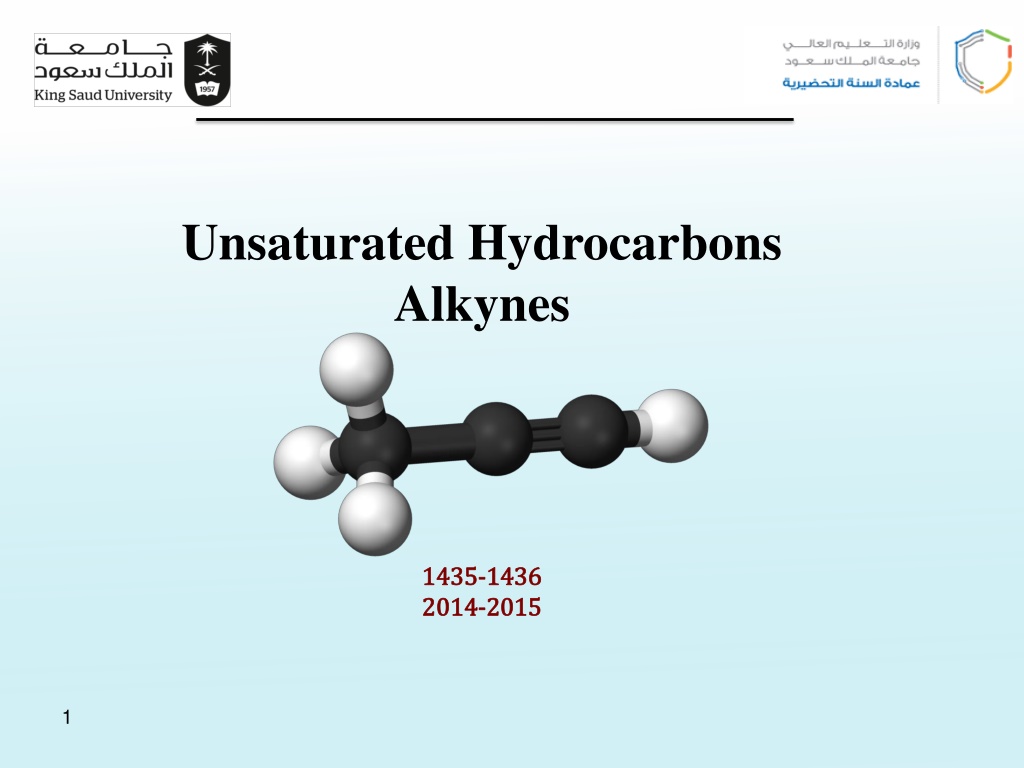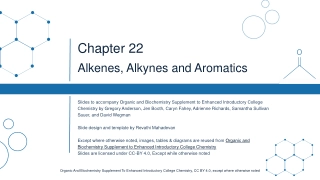Unsaturated Hydrocarbons Alkynes
Chapter three delves into the world of alkynes, focusing on their structure, hybridization, bonding, nomenclature, physical properties, preparation, and reactions. Alkynes are hydrocarbons with at least one triple bond, forming a homologous series with the molecular formula CnH2n-2. The sp hybridization of alkynes involves the linear arrangement of two sp-hybrid orbitals with a 180-degree bond angle. Ethyne (acetylene) serves as the simplest alkyne with a molecular formula of C2H2. Orbital overlap in ethyne results in the formation of sigma and pi bonds, leading to a linear molecular geometry.
Download Presentation
Please find below an Image/Link to download the presentation.
The content on the website is provided AS IS for your information and personal use only. It may not be sold, licensed, or shared on other websites without obtaining consent from the author. Download presentation by click this link. If you encounter any issues during the download, it is possible that the publisher has removed the file from their server.
Presentation Transcript
Unsaturated Hydrocarbons Alkynes 1435 1435- -1436 2014 2014- -2015 1436 2015 1
Alkynes Learning Objectives Chapter three discusses the following topics which have to be understood and memorized : The structure, hybridization and Bonding in alkynes Common and IUPAC naming of alkynes Physical properties of alkynes Preparation of alkynes Reactions of alkynes: addition reactions and acidity
Alkynes Alkynes: Molecular And Structural Formulae The alkynes comprise a series of carbon- and hydrogen- based compounds that contain at least one triple bond. This group of compounds is a homologous series with the general molecular formula of CnH2n 2 The alkyne triple bond is composed of one and two 2 covalent bonds, the triple bond can be terminal or internal. The simplest alkyne, ethyne (also known as acetylene), has two carbon atoms and the molecular formula of C2H2. The structural formula for ethyne is: H C CH 3
Alkynes sp Hybridization Of Alkynes This involves the mixing of one s- and one p-orbital forming two sp- hybrid orbitals of equivalent energy. The two sp-hybrid orbitals are oriented in a linear arrangement and bond angle is 180 to minimize the repulsion between them. The remaining two p orbitals (py and Pz) are unaltered 4
Alkynes Orbital Overlap IN Ethyne H C CH Molecular formula of ethyne is C2H2. In ethyne, each carbon atom is sp-hybridized. In this way, four sp-orbital are generated. One sp- orbital of each carbon atom by overlapping forms a sigma bond between carbon atoms. Remaining one sp-orbital of each carbon atom overlap with 1s- orbital of a hydrogen atom to produce two sigma bonds. Py-orbital and Pz-orbitals of each carbon by parallel overlapping form two pi-bonds between the two carbon atoms. Geometry (shape) of ethyne molecule is linear in which bond angles are 180o and C=C bond length is 1.20 5
Alkynes sp HYBRIDISATION OF ORBITALS in ALKYNES The electronic configuration of a carbon atom is 1s22s22p2 2s12p3 2s22p2 2 x sp 2p promotion hybridization 6
Alkynes 7
Alkynes Summary sp hybridization occurs when a C has 2 sigma bonds only sp hybridized orbital has 50% s and 50% p character The 2 sp hybrids point in opposite directions at 180o to each other Each sphybrid is involved in a( )sigma bond The remaining p orbitals form the 2pi bonds The triple bond is one ( )bond and two pi ( ) bonds. 8
Alkynes Common Nomenclature Of Alkynes The simplest alkyne its common name is acetylene Therefore the common names of alkynes are derived from acetylene ( e.g. Methyl acetylene) Examples: HC CH CH3 CH3 CH3 CH CH2 C C CH CH3 CH3 C CH Common : Isobutyisopropylacetylene Common : Methyl acetylene H3C C C Common: Isopropylmethylacetylene 9
Alkynes IUPAC Nomenclature of Alkynes Find the longest chain containing both atoms of the triple bond; this gives the root name. Add the ending yne to the root name. Number the chain, starting at the end closest to the triple bond. Give branches or other substituents names and numbers to locate their positions. Indicate the number of identical groups by prefixes di, tri, tetra, etc. Place the position numbers and names of the substituent groups in alphabetical order, before the root name. In alphabetizing ignore prefixes like tert., di, tri, etc. but include iso and cyclo. F 1 3 4 5 1 2 4 7 Br 1 3 2 2 3 9 6 4 CH HC C CH H3C C C 5 8 F CH3 5-Bromo-2-pentyne Not 1-Bromo-3-pentyne 6-Ethyl-4-nonyne 4,4-Difluoro-3-methyl-1-butyne 10
Alkynes Exercise 1) Give the IUPAC and common names of the following compounds b) C CH a) H2 C H2 C C C(CH3)3 - C C HC d) c) 11
Alkynes Physical Properties Nonpolar, insoluble in water. Soluble in most organic solvents ( hexane, benzene ). The boiling points and melting points of alkynes increase with molecular weight. Branching reduces the boiling point of alkynes Acidity of alkynes Terminal alkynes, R-C C-H, are more acidic than other hydrocarbons. For example, compounds b & d are more acidic than a & c. b) C CH a) H2 C c) Terminal alkynes H2 C C C(CH3)3 - C C HC Terminal alkynes d) 12
Alkynes Preparation of alkynes 1. (-2HX): Dehydrohalogenation of geminal or vicinal dihaloalkanes Br KOH/ alcohol NaNH2 Br Br heat heat Strong base C C C C - 2 HX X X 1,2-dihaloalkane Excess NaNH2 - 2HBr Br Br 13
Alkynes 2. From reaction of sodium Acetylide with Primary Alkyl Halides (Alkylationof acetylide with primary alkyl halide) liq NH3 C- Na+ + + R C R C CH Na H2 1/2 Sodium acetylide + + C- Na+ NaX X R' R' R C R C C For Terminal C C (use only Acetylene H-C C-H) (use Monosub. R-C C-H) NaNH2/ NH3 CH3Br Na - NaBr 14
Alkynes Reactions of alkynes Electrophilic Addition Reaction 1. Addition of hydrogen ( Hydrogenation) Alkynes can be partially reduced to cis-alkenes with H2 in the presence of poisoned catalysts. Pd(BASO4) or (NiB) Lindar s Catlyst C C + H2 H H or (Z) Cis- alkene Alkynes can be reduced totrans-alkenes using Na or Li in liquid NH3 H Na or Li / liq. NH3 C C + H2 H Trans -alkene or (E) Alkynes can be reduced toalkanes with H2 in the presence of catalysts as Ni H2/ Ni 15
Alkynes 2. Addition of halogen (Halogenation) HC CH + X2 HXC=CXH + X2 H XX C CXXH X X X + + X2 C C X2 C C C C X X X (X= Br or Cl) Tetrahalide Trans If we used one mole (alkene) two mole .alkane Br Br Br + Br2 + Br2 Br Br Br 16
Alkynes 3. Addition of hydrogen halide HC CR + HX HHC=CX R + HX HHHC CXXR X H + + HX C C HX C C C C H X H X (X= Br , Cl, I) A haloalkene A gem dihalide Br + HBr + HBr Br Br 17
Alkynes 4. Addition of water: Hydration H H H2SO4 / HgSO4 keto-enol tautomerism HO-H H + C C O H O carbonyl more stable an enol unstable Specific example: H H H H / H2SO4, HgSO4 H-OH C H H C C C H C C Acetylene O H H O H Vinyl alcohol (an unstable enol) Acetaldehyde (a stable carbonyl compound) O CH3 H / H2SO4, HgSO4 H-OH HC C CH3 C C H3C C CH3 O H H Acetone Propyne (an unstable enol) (a stable carbonyl compound) 18
Alkynes 1. An alkyne s name ends with (a) ane (c) yne 2. An alkyne function has .. pi bond(s). (a) one (c) three 3. Alkynes react with HCl by a mechanism called (a) elimination (c) 4. Alkynes react with water in the presence of a catalyst to give (a) a dialcohol (diol) (c) an enol 5. The conversion of alkynes to alkanes is an example of (a) oxidation (c) chlorination (b) -ene (d) diene (b) two (d) four (b) Markovnikov addition (d) substitution (b) an alkane (d) a dibromide (b) reduction (d) dehydration 19
Alkynes Thank You for your kind attention ! Questions? Comments 20




